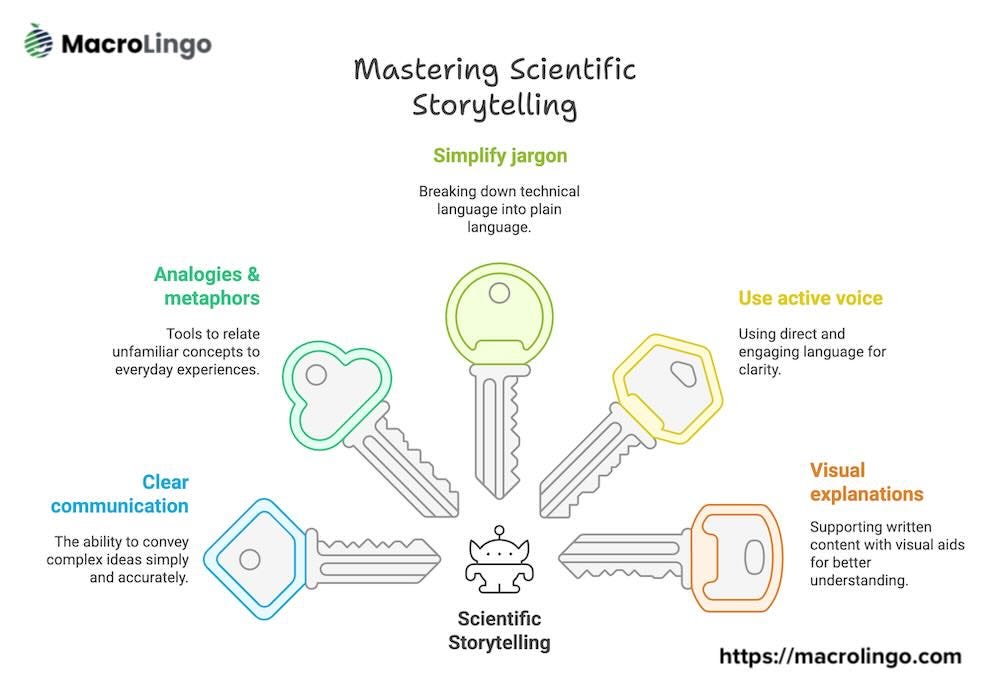Writing About Science for Everyone ...
Science should also be something that can be communicated: first to other scientists, then to everyone else .... We talk about HOW in this blog .....
Science is complicated, as it should be because the study of science takes time, intellect, and deep knowledge of complex topics. But science should also be something that can be communicated: first to other scientists, then to everyone else. So when you’re writing about science, your challenge (and my challenge as a science writer), is to bring the difficulty down to a level that everyday people can at least get their heads around it.
That’s the real goal of effectively writing about science for everyday people – make it accessible enough.
Writing about science for everyday readers isn’t about dumbing things down. It’s about creating a bridge between the lab and daily life. Research aims to meet curiosity in a way that resonates.
Good science communication uses skilled wording, analogies, and multimedia. It’s not just about simpler words. You’ll see this best at work in scientific media and among scientific influencers, like Neil de Grasse Tyson and Bill Nye.
In this post, we’ll look into the art of scientific storytelling, covering techniques to make your writing stand out, from hooking readers with compelling openings to explaining research findings accurately and accessibly.
Why science communication is so important these days
A 2023 study in Nature Human Behaviour” found that clear, consistent public health messaging strongly correlated with higher rates of vaccine acceptance and adherence to preventive measures. So we can see how effective science communication can have tangible, life-saving impacts on a global scale.
Building public trust in scientific research
Science communication fosters trust between researchers and the public, simplifies complex concepts, and empowers people to make informed decisions. Science communication makes scientific processes and findings transparent, building trust between researchers and the public. This trust is essential for implementing evidence-based policies and gaining public support for scientific initiatives.
Clear and accurate science communication acts as a bulwark against pseudoscience and conspiracy theories, especially important in an era of widespread misinformation on social media platforms.
As scientific issues increasingly intersect with daily life – from climate change to public health – accessible scientific information empowers individuals to make informed decisions about their lives and communities. Science communication also inspires future generations.
Empowering informed decision-making
Science literacy empowers individuals to make informed choices about their health, environment, and technology use. Understanding scientific concepts allows people to evaluate information and engage in societal debates. This knowledge fosters thoughtful decision-making at both personal and community levels.
Clear science communication helps build trust in research
Popular science writing makes complex ideas accessible
Improved science literacy leads to better decision-making
Your target reader is smart, but maybe not a scientist
Writing for everyday readers about science demands a profound grasp of your audience. The success of science education and outreach depends on identifying who you’re addressing and what matters to them.
Characteristics of non-scientific readers
Lay readers typically lack a scientific background. They find it challenging to grasp complex terms and ideas. These individuals seek straightforward, relatable content that resonates with their everyday experiences. Science outreach should aim to make information both accessible and captivating.
Common interests and motivations
Non-scientific readers are captivated by science topics that directly influence their lives. They’re into areas like:
Health and longevity
Child-rearing
Decision-making
Sports
Ethics
Science education initiatives can leverage these interests to craft engaging content. Focus on practical applications to raise curiosity and keep readers engaged.
Reading habits and preferences
Lay readers prefer concise, straightforward content because they don’t have much time, and there’s a seemingly infinite amount of content vying for their attention. Such readers, like you and me, often scan articles, seeking the main points.
Effective science outreach materials incorporate:
Short paragraphs
Clear headings
Visual aids
Everyday, conversational language
Adapting your writing style to these preferences can boost the effectiveness of your science education efforts. Your objective is to render complex concepts both accessible and intriguing to a broad audience.
This section is sponsored by Virtus Publishing: You can get 20% off self-publishing your book with Virtus ….
In a series of posts within posts, our friends at Virtus Publishing will provide tips and advice covering many aspects of publishing. This next series will be an ongoing selection of language tips, covering areas that many copy editors (and authors) find difficult. These will be short and to the point.
Virtus Publishing Language Tip #1: “Everyday” versus “every day”
A very common error that’s often seen concerns the incorrect use of “everyday” versus “every day.”
It’s important to understand the distinction. Let’s refer to Merriam-Webster’s Unabridged Dictionary for a definition. The end of the quoted material is denoted by a box (∎.)
everyday
adjective
1 a: used or occurring routinely or typically
b of clothes: suitable or designed for wear on ordinary days as contrasted with those worn on holidays or special occasions
2: lacking in unusual or distinctive quality or incident : plain, unvarnished, homely, ordinary, commonplace, drab
∎
Note that this is an adjective and that it’s one word.
Examples
Let’s look at a couple of examples of how “everyday” and “every day” would be used.
My friend Sal has a vintage Ford Mustang. It is not his everyday car.
This sentence would imply that since Sal’s car is vintage, it’s probably valuable, so he doesn’t use it often. The definition 1a above would apply, but in the negative sense: “(not) used or occurring routinely or typically.”
Based on this same information we might say this:
My friend Sal has a vintage Ford Mustang. He does not use it every day.
The meaning changes when you say “every day” (two words). In this case, “every” is modifying (describing) “day.” Using “every day” can be compared to saying “each day.”
Let’s look at another example.
In many cities, people take the subway every day.
This means that each day they take the subway.
It’s part of their everyday commute.
This means that the practice is part of their usual routine.
The nuances are subtle, but important. The best copy editors (and authors) understand the distinction between “everyday” (one word) and “every day” (two words). Do you?
Like this post? Follow Virtus Publishing on LinkedIn!
Have you ever wanted to publish a book? Virtus Publishing’s self-publishing services can make it happen! A global service provider, Virtus has the industry experience and dedicated staff to turn your book idea into reality.
Send an email to david@virtuspublishing.com to set up a free consultation. Mention the keyword “Mustang” and receive 20% off your first order.
Essential skills for writing about science
Writing about science for everyday readers demands a unique set of skills. These skills bridge the gap between complex scientific concepts and public understanding. Let’s explore the essential tools for making science accessible through effective writing.
Clear communication is vital in scientific storytelling. Scientists often lack formal training in this area, leading to gaps in information delivery. To overcome this, writers must master the art of simplifying complex ideas without losing accuracy.
One key skill is the use of analogies and metaphors. These tools help readers connect unfamiliar scientific concepts with everyday experiences. For instance, describing DNA as a blueprint for life makes the concept more relatable.
Break down technical jargon into plain language
Use active voice for clarity and engagement
Create visual explanations to support written content
Craft compelling introductions to hook readers
Developing these skills takes practice. Try rewriting a scientific abstract for a general audience or explaining a complex concept to a friend. These exercises will sharpen your ability to make science accessible through clear, engaging writing.
The goal of scientific storytelling is not just to inform but also to inspire curiosity and understanding. Focus on these essential skills, and you’ll be better equipped to share science with a wider audience.










